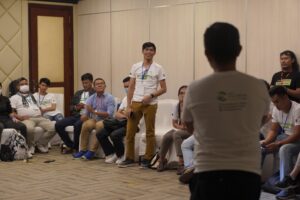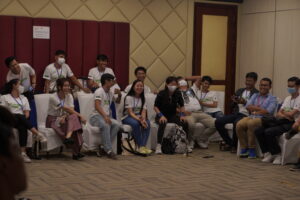Fake news and verification tools
In a world where news and information are widely disseminated through the internet and social media platforms, identifying between real and fake information has become a challenge. Digital technology has made information manipulation a bigger challenge in the last few decades. That is why in the digital security realms, fact-checking and information verification are necessary to prevent an individual from spreading fake news in the digital age.
At the Cambodia ICT Camp 2022, Mr. Sor Chandara held a workshop addressing “Fake news and verification tools” to disseminate helpful information about disinformation, misinformation, fact-checking, and verification tools with the participants. Chandara has extensive experience in publication and journalism and is currently working as DW Akademie coordinator and media and information literacy trainer.

As the session started, the speaker asked the 43 participants to differentiate between “misinformation” and “disinformation”. According to UNESCO, Disinformation is false information deliberately created to harm a person, social group, organization, or country. Misinformation, on the other hand, is all incorrect information but does not intend to harm any group or country.
News and information manipulation are global issues that are not exclusively found in global south countries, said Chandara. Fake news tends to spread rapidly, especially via social media platforms. Fake news and disinformation are often associated with political motives. However, with the recent uprising of social networks and the internet, spreading misinformation can also be used to defame individuals, responding to the interests and benefits of individuals and groups.

The speaker raised some challenges associated with fake news, such as disbelief in the media sector, social chaos, and digital security breaches. Chandara provided a practical example to show the consequences of creating and spreading fake news. During the COVID-19 pandemic, rumors, and false information about the death toll associated with the new vaccines spread on the internet, causing social unrest and generating fear among people. Mistrust raised quickly, making it hard for responsible bodies to cope with the spread of the pandemic.
Equally important, journalists and citizens should always fact-check information before distributing it to others. Users should pay attention to texts, photos, videos, and deep fakes. To the attentive participants, Mr. Chandara illustrated several fact-checking and information verification techniques that users can apply to avoid spreading false information: cross-check news between different platforms, avoid consuming news or media from unreliable sources, and verify information authenticity using official websites (governments and organizations). The Royal Government of Cambodia has been proactive in tackling fake news and has worked on the implementation of the national internet gateway (NIG), which will give the government control over the internet traffic in the country. While the government has stated repeatedly that Cambodia’s NIG will be used to combat fake news, domestic and international human rights organizations have stressed that it will seriously curb Cambodia’s internet freedoms.

Additionally, the speaker introduced “Tineye”, a website that allows users to reverse image search, to the audience. This website identifies whether a photo is old or has already been posted elsewhere. Chandara also presented “fotoforensics”, an image search engine enabling users to analyze digital pictures and see the image’s metadata.


